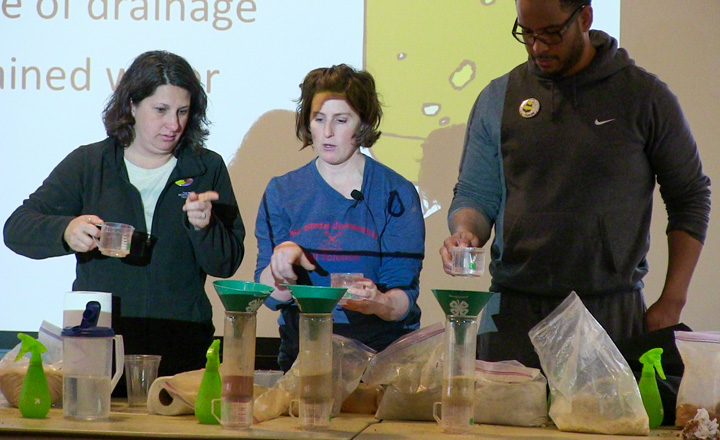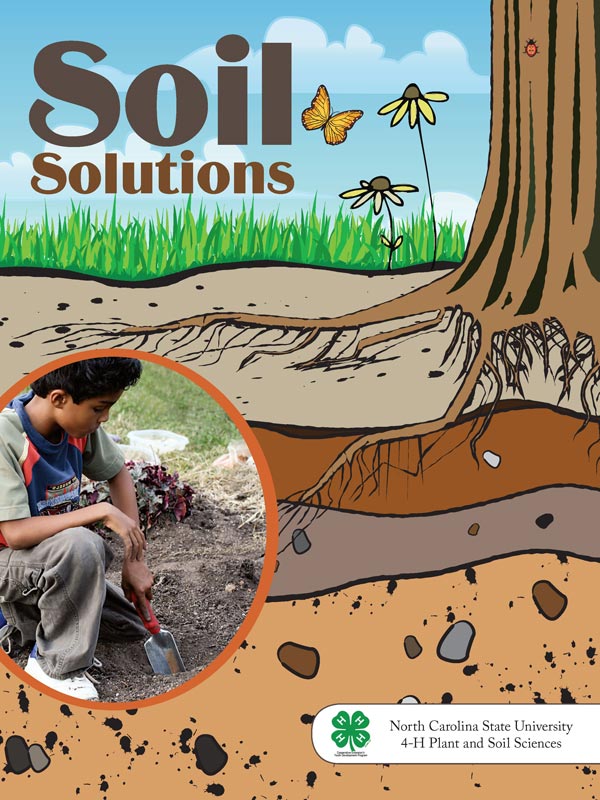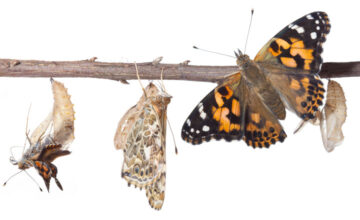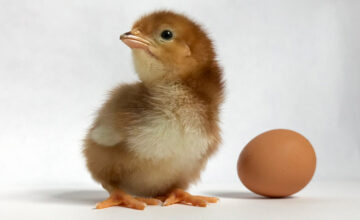
Curriculum Summary
Soil Solutions brims with hands-on science lessons that utilize the local school landscape to connect students to the world of soils and plants in an inviting and relevant way. Students will discover the soil beneath their feet, watch as a basil seed germinates before their eyes, and nibble on nutritious and delicious salad greens they have grown themselves. Activities are structured to foster wonder and curiosity and encourage ways to turn student questions into investigations. The teacher’s role becomes one of a collaborator and a partner in inquiry with their students. Aligned to meet North Carolina’s third-grade science standard course of study in plants and soils, the curriculum draws from current research and knowledge in crops, horticulture, and soil sciences.
Age range: 7-9
Grade level: 3/Elementary
Soil Properties
Purpose:
Using skills of observation, comparing, classifying, and communicating, students will discover the different characteristics of soil and how soil properties impact their daily life.
North Carolina Essential Science Standards (2023):
- LS.3.3.2 Construct an explanation to infer how the basic properties and components of soil determine its ability to support the growth and survival of many plants.
- ESS.1.2.2 Carry out investigations to compare the properties of different soil samples from local places relating their capacity to retain water, provide nutrients, and support the growth of plants.
Vocabulary Acquisition and Use
Common Core Language Arts
L.3.4. Determine or clarify the meaning of an unknown and multiple-meaning word and phrases based on grade 3 reading and content, choosing flexibly from a range of strategies.
- Use sentence-level context as a clue to the meaning of a word or phrase.
- Determine the meaning of the new word formed when a known affix is added to a known word (e.g., agreeable/disagreeable, comfortable/ uncomfortable, care/careless, heat/preheat).
- Use a known root word as a clue to the meaning of an unknown word with the same root (e.g., company, companion).
- Use glossaries or beginning dictionaries, both print and digital, to determine or clarify the precise meaning of keywords and phrases.
Life Skills
- Learning to Learn: Is curious, asks questions, learns how to do the process, how to observe, learns by doing.
- Problem Solving: Seeks solutions to simple problems and is able to consider a few selected alternatives.
- Critical Thinking: Ask questions before, during, and after acquiring information.
- Communication: Engages in group discussion.
- Cooperation: Has cooperative group experiences.
- Leadership: Learns to be a group member, learns to listen when others speak.
Soil and Water Relationships
Purpose
Using skills of observation, comparing, classifying, and communicating, students will discover the different characteristics of soil and how soil properties impact their daily life.
North Carolina Essential Science Standards (2023):
- LS.3.3.2 Construct an explanation to infer how the basic properties and components of soil determine its ability to support the growth and survival of many plants.
- ESS.1.2.2 Carry out investigations to compare the properties of different soil samples from local places relating their capacity to retain water, provide nutrients, and support the growth of plants.
Standards, not updated to 2023:
Measurement and Data
Common Core Math
3.MD.1 Solve problems involving measurement and estimation of intervals of time, liquid volumes, and masses of objects.
- Tell and write time to the nearest minute and measure time intervals in minutes. Solve word problems involving addition and subtraction of time intervals in minutes, e.g., by representing the problem on a number line diagram.
- Measure and estimate liquid volumes and masses of objects using standard units of grams (g), kilograms (kg), and liters (l).6 Add, subtract, multiply, or divide to solve one-step word problems involving masses or volumes that are given in the same units, e.g., by using drawings (such as a beaker with a measurement scale) to represent the problem.
Life Skills
- Learning to Learn: Is curious, asks questions, learns how to do the process, how to observe, learns by doing.
- Problem Solving: Seeks solutions to simple problems and is able to consider a few selected alternatives.
- Critical Thinking: Ask questions before, during, and after acquiring information.
- Communication: Engages in group discussion.
- Cooperation: Has cooperative group experiences.
Soil & Plant Growth
Purpose
Using skills of observation, comparing, classifying, and communicating, students will discover the different characteristics of soil and how soil properties impact their daily life.
North Carolina Essential Science Standards (2023):
- LS.5.2.1 Engage in argument from evidence to compare the characteristics of several common ecosystems (including estuaries and salt marshes, oceans, lakes and ponds, rivers and streams, forests, and grasslands) in terms of their ability to support a variety of populations.
- LS.3.3.1 Carry out investigations to explain how environmental conditions determine how well plants survive and grow.
- LS.3.3.2 Construct an explanation to infer how the basic properties and components of soil determine its ability to support the growth and survival of many plants.
Standards not updated to 2023:
Measurement and Data
Common Core Math
Represent and interpret data.
3.MD.4 Generate measurement data by measuring lengths using rulers marked with halves and fourths of an inch. Show the data by making a line plot, where the horizontal scale is marked off in appropriate units—whole numbers, halves, or quarters Text Types and Purposes.
W.3.2. Write informative/explanatory texts to examine a topic and convey ideas and information clearly.
- Introduce a topic and group related information together; include illustrations when useful to aiding comprehension.
- Develop the topic with facts, definitions, and details.
- Use linking words and phrases (e.g., also, another, and, more, but) to connect ideas within categories of information.
- Provide a concluding statement or section.
Range of Writing
Common Core Language Arts
W.3.10. Write routinely over extended time frames (time for research, reflection, and revision) and shorter time frames (a single sitting or a day or two) for a range of discipline-specific tasks, purposes, and audiences.
Life Skills
- Learning to Learn: Is curious, asks questions, learns how to do the process, how to observe, learns by doing.
- Problem Solving: Seeks solutions to simple problems and is able to consider a few selected alternatives.
- Critical Thinking: Ask questions before, during, and after acquiring information.
- Communication: Engages in group discussion.
- Cooperation: Has cooperative group experiences.
- Leadership: Learns to be a group member, learns to listen when others speak.
Seed Germination Experiment
Purpose
Students will understand the function of seeds and the different environmental requirements for seed germination.
North Carolina Essential Science Standards (2023):
- LS.4.1.1 Use models to explain that plants and animals have external structures that function to support survival
- LS.3.2.1 Carry out investigations to explain the structures and functions of plants and how they are essential for life.
- LS.3.2.2 Use models to exemplify the distinct stages of the life cycle of seed plants.
- LS.3.3.1 Carry out investigations to explain how environmental conditions determine how well plants survive and grow.
- ESS.1.2.2 Carry out investigations to compare the properties of different soil samples from local places relating their capacity to retain water, provide nutrients, and support the growth of plants.
- LS.K.1.1 Engage in argument from evidence to summarize the characteristics of living organisms and nonliving things in terms of their: structure, growth, changes, movement, basic needs.
Not updated to 2023:
Measurement and Data
Common Core Math
Represent and interpret data.
3.MD.3. Draw a scaled picture graph and a scaled bar graph to represent a data set with several categories. Solve one- and two-step “how many more” and “how many less” problems using information presented in scaled bar graphs. For example, draw a bar graph in which each square in the bar graph might represent 5 pets.
Research to Build and Present Knowledge
Common Core Language Arts
W.3.7. Conduct short research projects that build knowledge about a topic.
- Introduce a topic and group related information together; include illustrations when useful to aiding comprehension.
- Develop the topic with facts, definitions, and details.
- Use linking words and phrases (e.g., also, another, and, more, but) to connect ideas within categories of information.
Vocabulary Acquisition and Use
L.3.4. Determine or clarify the meaning of an unknown and multiple-meaning word and phrases based on grade 3 reading and content, choosing flexibly from a range of strategies.
Use sentence-level context as a clue to the meaning of a word or phrase.
Determine the meaning of the new word formed when a known affix is added to a known word (e.g., agreeable/disagreeable, comfortable/uncomfortable, care/careless, heat/preheat). Use a known root word as a clue to the meaning of an unknown word with the same root (e.g., company, companion).
Use glossaries or beginning dictionaries, both print and digital, to determine or clarify the precise meaning of keywords and phrases.
Life Skills
- Learning to Learn: Is curious, asks questions, learns how to do the process, how to observe, learns by doing.
- Problem Solving: Seeks solutions to simple problems and is able to consider a few selected alternatives.
- Critical Thinking: Ask questions before, during, and after acquiring information.
- Communication: Engages in group discussion.
- Cooperation: Has cooperative group experiences.
- Leadership: Learns to be a group member, learns to listen when others speak.
Pollination Partners
Purpose
Students will learn the function of the flower, including the processes of pollination and fertilization. Students will explore the relationship between the shape of the flower and the way it is pollinated. They will understand the flower as it relates to fruit and seed production.
North Carolina Essential Science Standards (2023):
- LS.5.2.3 Use models to infer the effects that may result from the interconnected relationships of plants and animals to their ecosystem.
- LS.4.1.1 Use models to explain that plants and animals have external structures that function to support survival.
- LS.3.2.1 Carry out investigations to explain the structures and functions of plants and how they are essential for life
- LS.K.1.1 Engage in argument from evidence to summarize the characteristics of living organisms and nonliving things in terms of their: structure, growth, changes, movement, basic needs.
Not updated to 2023:
Vocabulary Acquisition and Use
Common Core Language Arts
L.3.4. Determine or clarify the meaning of an unknown and multiple-meaning word and phrases based on grade 3 reading and content, choosing flexibly from a range of strategies.
Use sentence-level context as a clue to the meaning of a word or phrase.
Determine the meaning of the new word formed when a known affix is added to a known word (e.g., agreeable/disagreeable, comfortable/ uncomfortable, care/careless, heat/preheat).
Use a known root word as a clue to the meaning of an unknown word with the same root (e.g., company, companion).
Use glossaries or beginning dictionaries, both print and digital, to determine or clarify the precise meaning of keywords and phrases.
Life Skills
- Learning to Learn: Is curious, asks questions, learns how to do the process, how to observe, learns by doing.
- Problem Solving: Seeks solutions to simple problems and is able to consider a few selected alternatives.
- Critical Thinking: Ask questions before, during, and after acquiring information.
- Communication: Engages in group discussion.
- Leadership: Learns to be a group member, learns to listen when others speak.
Plant Growth Experiment: A Nutrient Study
Purpose
Students will observe the different stages of a plant life cycle and determine the requirements needed for each step. Students will measure the effects on growth and specifically seed development when environmental variables are manipulated. They will create questions and identify methods of collecting data to gather answers. The students will analyze their findings and compile summarizing conclusions.
North Carolina Essential Science Standards (2023):
- LS.5.2.3 Use models to infer the effects that may result from the interconnected relationships of plants and animals to their ecosystem.
- LS.3.2.1 Carry out investigations to explain the structures and functions of plants and how they are essential for life.
- LS.3.2.2 Use models to exemplify the distinct stages of the life cycle of seed plants.
- LS.3.3.1 Carry out investigations to explain how environmental conditions determine how well plants survive and grow.
- LS.3.3.2 Construct an explanation to infer how the basic properties and components of soil determine its ability to support the growth and survival of many plants.
Not updated for 2023:
Measurement and Data
Common Core Math
Represent and interpret data.
3.MD.4 Generate measurement data by measuring lengths using rulers marked with halves and fourths of an inch. Show the data by making a line plot, where the horizontal scale is marked off in appropriate units—whole numbers, halves, or quarters Text Types and Purposes.
Research to Build and Present Knowledge
Common Core Language Arts
W.3.7. Conduct short research projects that build knowledge about a topic.
Range of Writing
W.3.10. Write routinely over extended time frames (time for research, reflection, and revision) and shorter time frames (a single sitting or a day or two) for a range of discipline-specific tasks, purposes, and audiences.
Life Skills
- Learning to Learn: Is curious, asks questions, learns how to do the process, how to observe, learns by doing.
- Problem Solving: Seeks solutions to simple problems and is able to consider a few selected alternatives.
- Critical Thinking: Ask questions before, during, and after acquiring information.
- Communication: Engages in group discussion.
- Cooperation: Has cooperative group experiences.
- Leadership: Learns to be a group member, learns to listen when others speak.
- Social Skills: Has interactions that revolve around play, learns from and with others in small groups.
Salad Bowl Experiment
Purpose
Students will learn what plants need in order to grow and how to measure growth quantitatively, by collecting numerical data and qualitatively, through using their personal justifications. They will determine the “best” salad greens to grown in their classroom, based on their observations of plant performance in known environmental conditions.
North Carolina Essential Science Standards (2023):
- LS.3.3.1 Carry out investigations to explain how environmental conditions determine how well plants survive and grow.
- LS.K.1.1 Engage in argument from evidence to summarize the characteristics of living organisms and nonliving things in terms of their: structure, growth, changes, movement, basic needs.
Not updated for 2023:
Measurement and Data
Common Core Math
Represent and interpret data.
3.MD.3. Draw a scaled picture graph and a scaled bar graph to represent a data set with several categories. Solve one- and two-step “how many more” and “how many less” problems using information presented in scaled bar graphs. For example, draw a bar graph in which each square in the bar graph might represent 5 pets.
3.MD.4 Generate measurement data by measuring lengths using rulers marked with halves and fourths of an inch. Show the data by making a line plot, where the horizontal scale is marked off in appropriate units—whole numbers, halves, or quarters Text Types and Purposes.
Research to Build and Present Knowledge
Common Core Language Arts
W.3.7. Conduct short research projects that build knowledge about a topic.
Range of Writing
W.3.10. Write routinely over extended time frames (time for research, reflection, and revision) and shorter time frames (a single sitting or a day or two) for a range of discipline-specific tasks, purposes, and audiences.
Life Skills
- Learning to Learn: Is curious, asks questions, learns how to do the process, how to observe, learns by doing
- Problem Solving: Seeks solutions to simple problems and is able to consider a few selected alternatives.
- Critical Thinking: Ask questions before, during, and after acquiring information
- Communication: Engages in group discussion
- Cooperation: Has cooperative group experiences
- Leadership: Learns to be a group member, learns to listen when others speak
Composting
Purpose
Composting is a way to turn kitchen and waste materials into a rich amendment for the garden. Composting is also a great opportunity to practice environmental stewardship of the land by improving the structure of the soil, providing plants with nutrients, controlling weeds, reducing the need for watering, and keeping waste out of landfills.
North Carolina Essential Science Standards (2023):
- LS.5.2.3 Use models to infer the effects that may result from the interconnected relationships of plants and animals to their ecosystem.
- ESS.4.3.2 Engage in argument from evidence to explain how humans can adapt their behavior to live in changing. environments (e.g. recycling wastes, establishing rain gardens, planting native species to prevent flooding and erosion).
- ESS.1.3.1 Obtain, evaluate and communicate information to summarize ways in which humans use natural resources.
- ESS.1.3.2 Engage in argument from evidence to explain ways that humans can protect natural resources in the environment.
Not updated for 2023:
Vocabulary Acquisition and Use
Common Core Language Arts
L.3.4. Determine or clarify the meaning of an unknown and multiple-meaning word and phrases based on grade 3 reading and content, choosing flexibly from a range of strategies.
Use sentence-level context as a clue to the meaning of a word or phrase.
Determine the meaning of the new word formed when a known affix is added to a known word (e.g., agreeable/disagreeable, comfortable/ uncomfortable, care/careless, heat/preheat).
Use a known root word as a clue to the meaning of an unknown word with the same root (e.g., company, companion).
Use glossaries or beginning dictionaries, both print and digital, to determine or clarify the precise meaning of keywords and phrases.
Life Skills
- Learning to Learn: Is curious, asks questions, learns how to do the process, how to observe, learns by doing.
- Problem Solving: Seeks solutions to simple problems and is able to consider a few selected alternatives.
- Critical Thinking: Ask questions before, during, and after acquiring information.
- Communication: Engages in group discussion.




